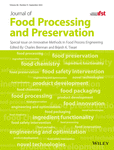Microwave drying of foamed tomato pulp: Optimization and mass transfer modelling
Prof. Mohammad Ali Khan, who served in the Department of Post-Harvest Engineering and Technology, Aligarh Muslim University, India, lost the battle of life against COVID-19 on April 28, 2021. He was a dedicated and experienced academician who played a pivotal role in development of the department. The work presented in this manuscript was conducted during his tenure as Chairman of the department. This is a modest attempt to pay tribute to Prof. Mohammad Ali Khan and all the other people who we lost to this pandemic. The world is no longer the same!
Abstract
The experiments were conducted to optimize different process parameters (microwave power, foam-mat thickness, and air temperature) based on physico-chemical properties (drying time, vitamin C, acidity, pH, and color difference) for foam mat drying of tomato pulp using microwaves. Egg albumin at 10% was incorporated as a foaming agent followed by 5 min of whipping to form a stable foam. The foam in different thicknesses (5, 10, and 15 mm) was dried in a modified microwave dryer at 480, 640, and 800 W power levels. The air temperature was varied between 40℃ and 50℃. Decrease in foam thickness and increase in microwave power levels and air temperature accelerated the rate of dehydration of the foam. Face-centered response surface methodology predicted 769.58 W power, 5 mm thickness, and 45.76℃ air temperature as the optimum values of process parameters. Besides, eight mass transfer models were fitted to the drying combinations.
Practical applications
Tomato powder is widely used ingredient and is produced widely throughout the world. Production of tomato powder using microwave foam mat drying is better in quality that conventional foam mat drying. The heating of foam with microwaves speeds up the drying process. This technology has the potential to be a fast and reliable method of drying at commercial level.




